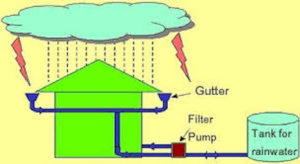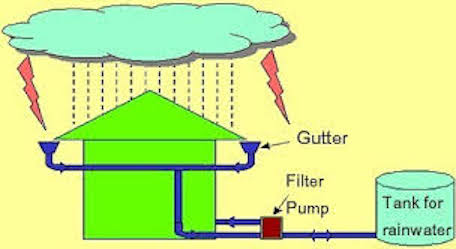 Simply put, Rainwater Collection is the practice of collecting and storing rain for future use. A Rainwater collection system combines components to collect, convey, and store for beneficial use. This can be as simple as rain barrels or a more complex system for potable drinking water. Both are important and have large scale benefits environmentally and socially.
Simply put, Rainwater Collection is the practice of collecting and storing rain for future use. A Rainwater collection system combines components to collect, convey, and store for beneficial use. This can be as simple as rain barrels or a more complex system for potable drinking water. Both are important and have large scale benefits environmentally and socially.
The use of rainwater collection, or sometimes referred to as harvesting, is nothing new. Evidence as far back as 1700 BC on the Island of Crete indicate a sophisticated rainwater collection system. It is known that the Romans constructed reservoirs and conveyance throughout the Mediterranean. In more modern times, many of our grandparents collected rainwater in rural areas in the United States and Europe. During World War II, many of the South Pacific Islands occupied by US forces collected rainwater for beneficial use.
A modern, centralized water system in urban areas expanded into outlying areas and eventually into more rural communities. Large and small public and community water systems made life easier for the average person and costs were minimal to the consumer. However, with increased demands from population, commercial and industrial demands, new fresh water supplies are becoming strained. The technology, equipment, testing, and efficiencies of rainwater collection and a supplementary, decentralized water system are helping to reduce that stress on today’s resources.
Expenses incurred to upgrade, expand, and repair our current centralized water systems will be high, but can be reduced by lessening the demand. The use of rainwater capture for non potable use, i.e., toilet and laundry facility, can reduce residential use by as much as 48%. The use of centralized water, disinfected to drinking water standards for irrigation of landscaping has a great impact on our resources. Along with better practices such as swales, drought tolerant plantings, passive on sight infiltration, pollution of our waterways are less threatened by stormwater runoff.
Groundwater levels at present are showing declines, excessive pumping, and other factors are causing wells to go dry or quality to decrease. Many locals are experiencing shifts in rainfall frequency and intensity. Declining habitat due to impacts of development, pollution from runoff, and declining river flow rates can be minimized by preventable, best practices such as rainwater collection, use, and infiltration.

